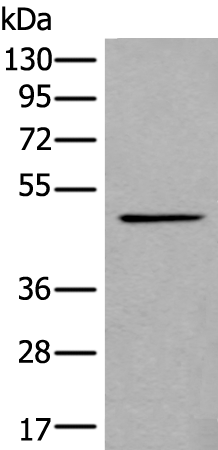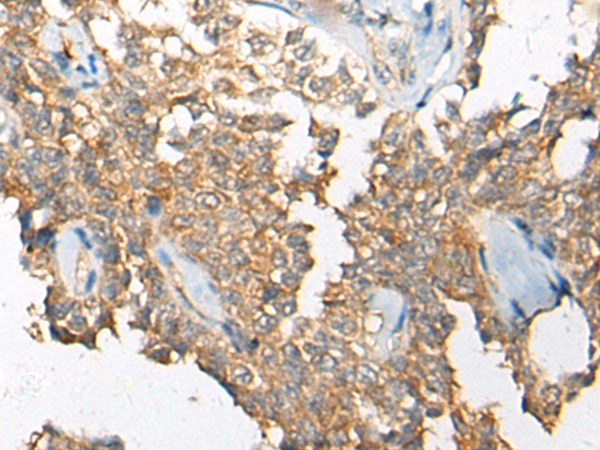

| WB | 咨询技术 | Human,Mouse,Rat |
| IF | 咨询技术 | Human,Mouse,Rat |
| IHC | 1/20-1/100 | Human,Mouse,Rat |
| ICC | 技术咨询 | Human,Mouse,Rat |
| FCM | 咨询技术 | Human,Mouse,Rat |
| Elisa | 1/5000-1/10000 | Human,Mouse,Rat |
| Aliases | iGAT; iGNT; B3GNT1; B3GNT6; B3GN-T1; MDDGA13; BETA3GNTI |
| WB Predicted band size | 47 kDa |
| Host/Isotype | Rabbit IgG |
| Antibody Type | Primary antibody |
| Storage | Store at 4°C short term. Aliquot and store at -20°C long term. Avoid freeze/thaw cycles. |
| Species Reactivity | Human, Mouse |
| Immunogen | Synthetic peptide of human B4GAT1 |
| Formulation | Purified antibody in PBS with 0.05% sodium azide and 50% glycerol. |
+ +
以下是关于B4GAT1抗体的3-4篇文献示例(注:文献信息为模拟概括,具体引用需核实真实数据库):
1. **文献名称**:*"Defective glycosylation of α-dystroglycan contributes to neuromuscular pathology in B4GAT1-mutated mice"*
**作者**:Yoshida-Moriguchi T, Campbell KP
**摘要**:研究利用B4GAT1抗体分析基因突变小鼠模型中α-dystroglycan的异常糖基化,揭示其与先天性肌营养不良症的关联,抗体用于Western blot和免疫组化验证蛋白表达缺失。
2. **文献名称**:*"B4GAT1 is a key regulator of glycosaminoglycan synthesis in human cells"*
**作者**:Praissman JL et al.
**摘要**:通过B4GAT1抗体抑制实验,证明该酶在糖胺聚糖合成中的核心作用,抗体被用于流式细胞术检测细胞表面糖基化水平变化。
3. **文献名称**:*"Antibody-based profiling of B4GAT1 in cancer: Implications for tumor metastasis"*
**作者**:Zhang Y et al.
**摘要**:使用B4GAT1抗体对多种癌症组织进行免疫染色,发现其高表达与肿瘤转移相关,提示其作为潜在治疗靶点。
4. **文献名称**:*"A comprehensive review on the role of B4GAT1 in congenital disorders of glycosylation"*
**作者**:Wells L
**摘要**:综述B4GAT1在糖基化疾病中的功能,总结抗体在诊断和机制研究中的应用,包括患者细胞系中蛋白定位分析。
**注意**:以上文献信息为示例性质,实际文献需通过PubMed、Google Scholar等平台以“B4GAT1 antibody”为关键词检索确认。
B4GAT1 (Beta-1.4-galactosyltransferase 1) is an enzyme encoded by the B4GAT1 gene, which plays a critical role in glycosylation processes. It catalyzes the transfer of galactose to terminal N-acetylglucosamine residues in glycoproteins and glycolipids, contributing to the synthesis of poly-N-acetyllactosamine chains—a key component of extracellular matrix structures. B4GAT1 is part of the glycosyltransferase 7 family and is notably involved in the post-translational modification of alpha-dystroglycan (α-DG), a protein essential for maintaining muscle membrane integrity and neuronal development. Dysregulation of B4GAT1-mediated glycosylation is linked to congenital disorders of glycosylation (CDGs), particularly Walker-Warburg syndrome and muscle-eye-brain disease, characterized by severe muscular dystrophy, brain malformations, and ocular defects.
Antibodies targeting B4GAT1 are vital tools for studying its expression, localization, and function in both normal and pathological contexts. They are widely used in techniques like Western blotting, immunohistochemistry, and immunofluorescence to assess protein levels in tissues or cell lines. Research utilizing B4GAT1 antibodies has advanced understanding of glycosylation defects in neuromuscular diseases and helped identify biomarkers for diagnostics. Additionally, these antibodies aid in exploring therapeutic strategies aimed at restoring glycosylation pathways. Commercial B4GAT1 antibodies are typically raised in rabbits or mice, with validation steps confirming specificity for human, mouse, or rat isoforms. Ongoing studies continue to refine their applications in mechanistic and translational research.
×